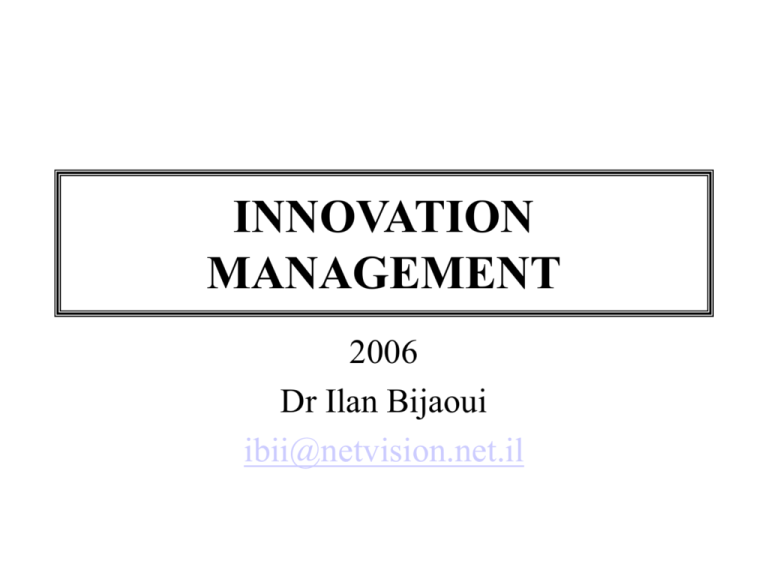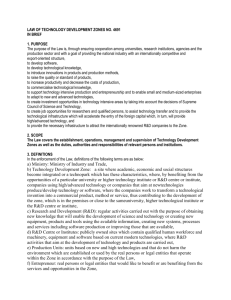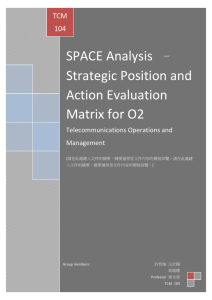
INNOVATION
MANAGEMENT
2006
Dr Ilan Bijaoui
ibii@netvision.net.il
THE KNOWLEDGE DRIVEN ECONOMY
• Knowledge, new factor of production”
Drucker P.(1998”From capitalism to knowledge society “in Neef D. The
Knowledge Economy Woburn MA Butterworth)
• Knowledge in Production (learning by doing) and
in Consumption (learning by using)
• Broadened type of measures, not only R&D
• Fostering innovation culture, Setting up legal and
financial framework, Gearing research closer to
innovation
• Systemic Approach –Diffusion of innovationsimpact on knowledge
Source: Cowan R. Van de Paal G.(2000) Innovation Policy in a Knowledge-Based
Economy A MERIT study Commissioned by The European Commission Enterprise
Directorate General
Schumpeter identifies innovation as the dynamic "deus ex
machina" of capitalism. In his own words (1934):
The fundamental impulse that tests and keeps the capitalists'
engine in motion comes from the new consumers' good, the
new methods of production or transportation, the new
markets, the new forms of industrial organization that
capitalist enterprise creates. (p. 137)
Schumpeter, J.A. (1934). The theory of economic development.
Cambridge, MA: Harvard University Press
INVENTION - DEFINITION
THE INNOVATION ECOLOGY AND
BREAKTHROUGH DILEMNA
•
•
•
•
•
•
University-Education – Multi disciplinary
Research Organizations – Not development
Government funding agencies -Alternatives
Technology companies - Risk
Investors
Consumers
INVENTION APPROACHES
Theory driven
Way of thinking leads to
invention Einstein
Pasteur from theory to need
Method driven:
instrumentation enables
previously unknown
observations-invention
Galileo (telescope)
experimental technicsData Driven : reveals
Need driven: identify
anomaly in data, a surprising problems and seek solutions
possibility Mendel-burrs –
Edison
Velcro Fleming-(penicillin)
INNOVATION DEFINITION
• The ability to manage knowledge creatively in
response to market-articulated demands & other
needs. (Source: Managing National Innovation Systems, OECD 1999)
• New Creations with Economic Significance
Products what is being produced; Process How
goods are produced
Source: Edquist C. & Johnson B.(1997) “Institutions and organisations in
systems of innovation in Edquist(ed) Systems of Innovations: Technologies,
Institutions and Organizations, London & Washington Pinter/Cassell
Academic)
TYPES OF INNOVATION
• Product Innovation:
The creative development and commercialization
of radically new products, often grounded in new
technology and linked to unmet customer needs
• Process Innovation:
The development of new ways of producing
products that lead to advantage in cost.
• Business Innovation:
The development of new business and new way of
conducting business that provides unbeatable
competitive advantage
Source:Arthur D. Little “ Global Survey on Innovation” in Jonash R.S. The
Innovation Premium, Persus Books, 1999 p 114-136
TYPES OF INNOVATION
• Product Innovation:
Changes in the things (products/services), which an
organization offers.
• Process Innovation:
Changes in the way in which they are created or
delivered
• Position Innovation:
Changes in the context in which they are created or
delivered.(Ford, Lucozade drink)
• Paradigm Innovation:
Changes in the underlying mental models which frame
that the organization does,(low cost airlines)
Source:Tidd J. Bessant J Managing innovation John Wiley 2006 p 10
Platform Robust Design Intel PG cyclodextrin detergents odor
control Febreze
RESEARCH & DEVELOPMENT
• RESEARCH
Search
Planning
New Knowledge
Non Public Knowledge
Future Implementations
• DEVELOPMENT
Implementation
Direction
Product/Process
Improvement
Business Objective
THE PLACE OF R&D/INNOVATION
AS A COMPONENT OF GNP
Education
Management
Labor
Goods &
Services
Capital
Consumer
R&D
New Concepts
Innovation
Raw Materials
MARKETING HIGH TECH
Source: Mohr j. Sengpta S Slater S
Marketing High Technology
Products and Innovations Second
Edition Pearson Prentice Hall 2004
p 1-16
INITIATING FACTORS TO
INNOVATION
Business Objectives
• Financial goals
• Sales growth
• Market Share
• Globalization
• Material costsavailability
• Shorter Life Cycle
• Suppliers initiatives
Environmental Change
• Technology
• Regulation
• Invention
• Demography, lifestyle
• Customer requests
• Rivalry-Alliances
ENTREPRENEURIAL BREAKTHROUGH VERSUS
CORPORATE INCREMENTAL IMPROVEMENTS
• Entrepreneurial breakthroughs: unorthodox approach,
creativity
• Incremental Improvements: body of knowledge
conventional way of thinking
• Edison little schooling. Steve Wozniak Apple, no
graduation; Bill Gates, dropped out Harvard, Michael Dell
quite university –Dell Computers (Bhide2000 p36
• Large firms: Intel instruction per second grew per 3milion
% ; P&G 1250 PhD, 3800 per years 24000 active patents
• Hybrid education?
Source; Baumol W.J.(2005) “Education for Innovation” in Innovation
Policy and the Economy Vol 5 National Bureau of Economic Researches
Inventor and Innovator:
Electric suction sweeper : J.Murray Spengler WH Hoover
Sewing machine: Elias Howe Isaac Singer
DEFINITION OF INNOVATION POLICY
• A Set of Policy Actions to Raise the Quantity and
efficiency of Innovative Activities
• Innovation Activities Refers to the Creation,
Adaptation and Adoption of new improved
Products, Processes, or Services
• At the Level of the Firm or the Institution, Local,
National
• To Increase Competitiveness: Productivity, Profit
or Market Share
Source: Cowan R. and Van de Paal G (2000). Innovation Policy in a
Knowledge Based Economy Merit The European Commission p 9
• Tacit & Specialized knowledge
• Geographic clustering in knowledge generation
• Models of diffusion process: Education system
broader than the industry structure of the
innovative industries
• Knowledge Bases. Norwegian offshore and food
processing industry Smith K.(1998 Indicators and data for
European analysis (IDEA) European Commission )
FOUNDATIONS
• From system of production to system of innovation:
backward linkages Learning by doing and learning by
searching; Life cycle perspective; Open economy;
Quality of Demand
• Home market and economic specialization
From innovation interactive process to National
innovation system
• Dimensions: Structure of the system: What are the
most developed production and competencies?
Institutional set up: How does production, innovation
an learning take place?(Freeman C.1995 “History co
evolution and economic growth” IIASA working paper 95-76 IIASA
Laxenburg)
Schumpeterian strategies
Pioneers; Adaptionist; Imitators; Complementors
•
(NaleBuffB.J. & BrandenburgerA.M. (1996) Co-opetition Harpers Collins
London). Danish –(Edquist C. Lundvall B.A.(1993) “Comparing the Danish
and Swedish Systems of innovation” in Nelson R.R. National Innovation Systems
A comparative Analysis Oxford University Press Oxford
Mixed strategies: Japan Adaptionist, Imitators,
Complementors (Freeman C.(1988) “Japan: an ew national innovation
system? In Dosi G. Freeman C. Nelson R.R.Silverberg G. Soete L.Technology
Chang and Economic Theory Pinter London
Source: Lundvall B.A. Johnson B. Adessend E.S Dalum B.2002 “National Systems of
production, innovation and competence building. Research Policy 31(2002) 213-231
• Evolutionary Nature: Paradigmatic Changes,
Structural Adjustments (Galli and Teubal 1997);
Predictive Elements (Edquist)
• Learning economy:
Short Term economic efficiency
Long Term knowledge efficiency (Jessop B.1999 “The state
and the contradictions of the knowledge-driven economy. Development
Research Working papers. Department of Development & Planning )
THE SYSTEM OF INNOVATION-DEFINITION
• The Network of Institutions in the Public & Private
Sectors whose the Activities & Interactions, Initiate,
Import, modify & Diffuse Technologies.
Freeman C.(1987) Technology Policy and Economic Performance: Lessons
from Japan London Frances Pinter)
• Narrow Definition-Organizations exploring & Searching
R&D dept., Institutes, Universities; Broader-Economic
Structure (Production, Marketing)
Lundvall (1992) National Systems of Innovation: Towards a Theory of Innovation &
Interactive Learning London Pinter):
Archibugi D. Howells J., Michie J(1999). “Innovation Systems and Policy in a
Global Economy’ in Innovation Policy in a Global Economy Cambridge
University Press,
• Technological Innovation
Edquist (1997) Systems of Innovation Their emergence and characteristics in
Edquist C.1997 Systems of Innovation: Technologies, Institutions and
Organizations London Pinter (Nelson, Rosenberg –1993 Technological
Innovation and national systems in Nelson R.R.1993 National Innovation
systems: : A comparative analysis New York Oxford Press University ).
• Institutional Innovation (Lundvall);
• Social-Educational Innovation – Freeman (1988 )
Source: Lundvall B.A. Johnson B. Adessend E.S Dalum B. “National Systems of
• Set of distinct institutions which jointly and
individually contribute to the development &
diffusion of new technologies and which provide
the framework with which governments form and
implement policies to influence the innovation
process OECD (1999)
Source:Metcalfe 1995 The Economic Foundations of Technology Policy:
Equilibrium and Evolutionary Perspectives” in Stoneman P. Handbook of the
Economics of Innovation and Technological Change pp 409-512 Blackwell,
London
SYSTEMS OF INNOVATION
GOVERNMENT
BOUNDARIES
COMPONENTS
Organizations
Institutions
Firms
Standards
Interaction
Universities
Patents
Other services
Support
FUNCTIONS
R&D
Supply
Relation
Production
Marketing Education
OVERALL FUNCTION
COMPONENTS Edquist C. & Johnson B.(1997) “Institutions and
organisations in systems of innovation in Edquist(ed) Systems of Innovations:
Technologies, Institutions and Organizations, London & Washington
Pinter/Cassell Academic
• Organizations: Perform activities Structures with
Purposes: Companies, Universities, Venture capital
• Institutions: Provide incentive framework. Regulate
relations between, Individuals, Groups, Organizations
(Patents, Laws). Rate & Direction of innovative
activities(Johnson B. 1988 “Institutional approach to the small country
problem” in Freeman, Lundvall Small Countries Facing the Technological
Revolution, Pinter London New York )
Edquist C.(2001) “The Systems of Innovation Approach and Innovation Policy: An
account of the state of the art” DRUID Conference June 12-15 2001
Time-Horizon of agents; Role of Trust, Actual mix of
Rationality(Lundvall B.A.”National Systems of production, innovation and
competence building, Research Policy 31(2002) 213-231)
•
Relations, Interaction between Organizations/Institutions
FUNCTIONS
• Overall function: Produce, Diffuse, Use Innovations
• Research (Basic, Development); Implementation
(Manufacturing); End Use (customers, process outputs);
Linkage(bring together knowledge); Education
Liu X.& White S.(2000): “Comparing Innovation Systems: A Framework and
Applications to China’s Transitional Context’ Research Policy 2001)
• Create New knowledge; Guide the direction of the
search process, Supply resources, Facilitate
creation of external economies, facilitate
formation of markets
Johnson A., Jacobsson S.(2001). “ The Emergence of a Growth
Industry:Analysis of the German, Dutch and Swedish Wind Turbine Industries
Schumpeter Conference Manchester 2000 )
• Create human capital; create & diffuse
technological opportunities; products; incubate in
order to provide facilitie; facilitate regulation for
technologie, materials & products; legitimise
technology & firms; create markets; enhance
networking; direct technology & market; facilitate
financing; create labour market
Johnson A., Jacobsson S.(2001). “ The Emergence of a Growth
Industry:Analysis of the German, Dutch and Swedish Wind Turbine Industries
Schumpeter Conference Manchester 2000 )
RELATIONS FUNCTIONS / COMPONENTS
• Several organizations can fulfill one function (R&D:
firms research centers)
• One organization can fulfill several functions:
university provides new knowledge & education
• Function and institutions (R&D and governmental
support and educational system)
• Institutions & organizations: mutual embedded:
organizations in institutional environment and
institutions in firms (book keeping)
BOUNDARIES
• Supranational, National, Regional, Sectorial
• Spatially(Geographically), Sectorially, Functionally
• Public Action from Supply & Demand Side
• Deficient functions-system failure: Problems solving
Functions missing or inappropriate
Organizations inappropriate
Institutions inappropriate
Interactions or Links inappropriate
• Design & Implementation of Innovation Policy
THE STATE-INNOVATION POLICY
• R&D Policy
• Technology Policy
• Infrstructure Policy
• Education Policy
• Regional Policy
NATIONAL SYSTEM OF INNOVATION
Environment and Infrastructure conditions
Innovation Systems
Knowledge
Generation
Diffusion &
Use
Country Performance: Growth, Job creation, Competitiveness
Source: OECD, Managing National Innovation Systems, Paris 1999 p 21-48
ENVIRONMENT & INFRASTRUCTURE
CONDITIONS – Institutions & Support
Organizations
Macroeconomic and Regulatory context
Education &
Training systems
Communication
Infrastructure
Corporate
governance &
finance
Product & factor
market conditions
National Innovation Capacity
KNOWLEDGE GENERATION, DIFFUSION
& USES – Active Organizations
Firm Capabilities
& Networks
Science System
Other Research
Bodies
Supporting
Institutions
INNOVATION SYSTEMS/NETWORKS
Global Innovation Networks
Regional Innovation Systems
Clusters of Industries
National Innovation System
LEVELS OF NIS ANALYSIS
Macro Level
Macro Clustering analysis
Functional analysis
Interactions among firms, , firms and others, technology diffusion, personnel mobility
Sectoral clustering approach
Meso Level
Spatial clustering approach
Functional clustering approach
Other firms
Micro Level-Firm
Non market institutions
SPECIALISATION IN NIS- overall function
Technological Specialisation
Scientific Specialisation
Agro food Health Computing M.Eng.
Size Standard of Industrial
Living
Specialisation
AUS. B, DEN B, DN, FR, NL, J, K
NL
D, IT, S UK
Export Specialisation
Food
AUS, DN, NL
Pharmaceuticals
B, DN, SW
Computing
J, USA, UK, NL
SW, D
FRENCH FINANCE INNOVATION
POLICY
GOVERNMENT
Type title here
Universities
Researchers
R&D Budget
Basic Research
Training
Mission Oriented Research
Incentive to Industry
Technological Programmes
Space, Aeronautics Nuclear, Telecom.
R&D
Tax Credit
NORVEGIAN SYSTEM OF INNOVATION
PARLIAMENT
GOVERNMENT'S RESEARCH POLICY BOARD
Ministeries, Industry & Trade, Finance
Church, Education, Research
Committee of Research Policy
Public Funds
Banks
Regional Dvt Fund
Environment
Medicine, Science & Technology
Industry & Energy
Environment, Bioproduction
Corporate R&D
Universities
Research Institutes
MUnicipalities
County
Support Organisations (Venture Capital) &Institutions (Technological Transfer)
ISRAEL SYSTEM OF INNOVATION
CHIEF SCIENTIST
Ministry of Industry
Other Ministries
Grants to Firms
MAGNET
Biotechnology
Satellite Communication
Technological Incubators
TNUFA
BI NATIONAL FUNDS
US BIRD
U.k
FRANCE
NETHERLANDS
VENTURE CAPITAL FUNDS EU R&D FRAMEWORK PROGRAM
YOZMA
OTHERS
OCS R&D Grants are available to companies whose
projects have been approved by the Research
Committee of the OCS. The grants are a percentage
(between 30% and 66%, depending on circumstances)
of the estimated R&D expenditure. In cases where the
government assisted R&D results in a commercially
successful product, the developers must repay the grant
through royalties.
The MAGNET program allows the encouragement of
generic- pre- competitive technological cooperation
executed by consortia of industrial companies and
academic research institutes.
Multi-lateral Programs
European Union - The Sixth Framework Programme
of the European Union's Commission on Science,
Research
and
Development
EUREKA - the Israeli Liaison Office of EUREKA
CELTIC
The
European
Cooperation
in
Telecommunications
GALILEO - Galileo is a Euro 4B project managed by
the EU and ESA for a new Global Navigation Satellite
System
Bi-National Research
India - Second Call for Proposals – India-Israel Initiative
for Industrial R&D (i4RD)
Finland - Call for Proposals For Joint R&D Projects in
Information and Telecommunications Technologies
Victoria (Australia) First Call for Proposals – VISTECH
FUND - Victoria (Australia)- Israel R&D Cooperation
Program
France MOU for cooperation between the OCS and
ANVAR
Second Call for Proposals - Israel-France Industrial
R&D Cooperation Program
FIRAD - The France-Israel Industrial R&D
Cooperation Framework new website
Germany - German-Israel Technological & Industrial Cooperation
Maryland / Israel Development Fund (MIDF) NEW!! MarylandIsrael call for proposals
Italy - Italy- Israel Industrial Cooperation Programs
Sweden - MOU for Industrial Cooperation between Swedish and
Israeli Companies
Ireland *
The Netherlands
Portugal
Spain
USA: BIRD - Binational Industrial Research and Development
Foundation
USA: USISTC - US-Israel Science and Technology Commission
UK: BRITECH - UK-Israel Industrial R&D Foundation
Canada: CIIRDF - Canada-Israel Industrial R&D Foundation
India - MOU for Industrial Cooperation between India and Israel
China - THE PROGRAM FOR CHINESE-ISRAELI
TECHNOLOGICAL COOPERATION
Hong Kong - HONG KONG -ISRAEL TECHNOLOGICAL
COOPERATION
KORIL-RDF Korea-Israel Industrial R&D Foundation (the web site
www.koril-rdf.or.kr is under constraction).
Singapore: SI-IRD - Singapore-Israel Industrial R&D Fund
Multinational Corporations
Technological incubators
Technological incubators are support corporations that give
fledgling entrepreneurs an opportunity to develop their
innovative technological ideas and set up new businesses in
order to commercialize them. The incubator program is applied
in all parts of the country, under the guidance and with the
support of the Office of the Chief Scientist of the Ministry of
Industry and Trade.
The program supports novice entrepreneurs at the earliest stage
of technological entrepreneurship and helps them implement
their ideas by turning them into exportable commercial products
and forming productive business ventures in Israel
Budget
Between US $350,000 to US $590,000 per two years.
Grant
Level of grant: 85 percent of approved budget.
Ownership
Regular Incubators – General manager directives 8.2
Initial ownership in the Project Company is as follows:
At least 50 percent— the developer/entrepreneur;
At least 10 percent— key staff members other than
developers/entrepreneurs;
Up to 20 percent— the provider of supplementary financing (i.e.,
additional to the State grant) for project implementation. (Of course,
this may also be the developer/entrepreneur.);
Up to 20 percent— the incubator
Privatized Incubators – General manager directives 8.3
Initial ownership in the Project Company is as follows:
Between 30 to 70 percent— the developer/entrepreneur;
Between 30-70 percent— the incubator (including the provider
of supplementary financing)
State Support
.1Incubator Project
The Grant between US $150,000 to US $250,000 per year for up
to two years, i.e., total between US $300,000 to US $500,000.
Level of grant: 85 percent of approved budget.
.2
Incubator Administration
Grant of up to up to NIS 729,500 per annum (about $175,000),
including the incubator director's salary, administrative expenses,
outlays for sorting and studying of ideas, and organizational
expenses for project commercialization and marketing.
Results
By the end of June 2004, 806 projects had left the incubators (in addition
to the 200 that remained). Of these "graduates," 45 percent have
continued on their own steam and 55 percent have been discontinued.
Most of the ongoing projects have managed to attract private
investments.
The total private investment obtained thus far is in excess of US $773
million.
The technological incubators have become massive repositories of
potential ideas for new high-tech venture funds in the future.
European Union
6th 7th Framework Agreement
An active participant in the European Union’s R
& D Framework program since 1996
Israel continues to be active in the 6th Framework
Agreement that began in November 2002
Technological Incubator Projects
• 23 technological incubators operate
• 200 projects operate currently
• 735 projects have left the incubators in the last
decade
• 54% have received further private investment
Innovation climate in Israel
Scientists & Technicians per 10,000
Workers
140
140
120
100
83
80
80
60
60
55
55
45
43
33
40
33
32
25
20
0
Israel
US
Japan
Germany
Canada Switzerland Taiwan
UK
Ireland
Italy
Singapore
Spain
Innovation climate in Israel
Patents
Number of patents (per 10,000) registered in the U.S.
during 2003
3.5
2.98
3
2.96
2.5
2.04
2.02
2
1.92
1.74
1.5
1.5
1
0.7
0.68
0.5
0
J
an
ap
Ta
iw
an
l
ae
r
is
itz
w
S
n
la
r
e
d
de
e
Sw
n
n
la
n
Fi
d
Ge
y
an
rm
c
an
r
F
e
B
in
a
t
ri
Israel - An annual increase of 20%
Source: BDI - Business Data Israel






